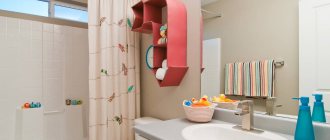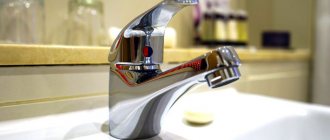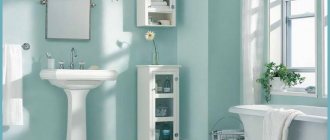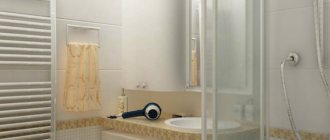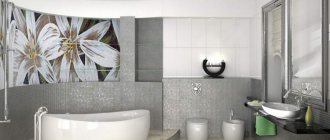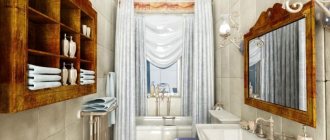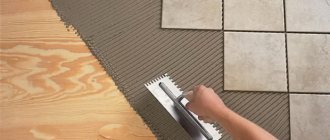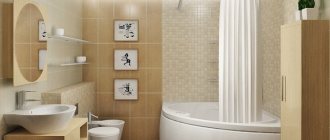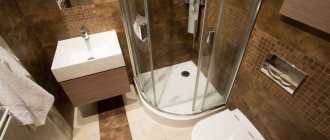Ensuring a comfortable microclimate in the bathroom and shower room can be problematic. High levels of humidity have a detrimental effect on cabinets, mirrors and cabinets, facilitating the growth of mold.
If natural ventilation cannot cope, then you can install an exhaust fan in the bathroom - the unit forcibly removes exhaust humid air from the room.
We will tell you how to choose the appropriate model, and also describe the step-by-step process of installing the equipment. The installation technology is quite simple, the main thing is to take into account some connection nuances and follow the instructions below.
The need to install a fan in the bathroom
A standard bathroom is a room with frequent changes in temperature and humidity, as well as a place where aggressive cleaning agents are used. Without effective air removal, the microclimate becomes uncomfortable, and expensive surface cladding will deteriorate.
There are other reasons for installing a fan:
- steam extraction;
- eliminating dampness and mold on walls and ceilings;
- elimination of unpleasant odors;
- reducing the risks of allergies and respiratory diseases;
- correct direction of air flow in a room without windows.
Important! With only natural ventilation, unpleasant odors and polluted air are inevitable. The line gradually becomes clogged, and a household device minimizes these risks.
Types of bathroom fans
Which of the fans on the market would be best for decorating a bathroom? You should pay attention to their varieties.
Axial models
The devices are designed as a wheel in a cylindrical body. There are cantilever blades along the surface of the product. The structure is fixed on an axial electric motor. The operating principle is based on the rotation of the wheel, capturing air by the blades and moving it. Axial fans are installed in the shaft openings.
Advantages:
- high efficiency - 100 cubic meters are cleaned in 1 hour;
- ease of installation - into the wall surface;
- operate without an air vent system;
- suitable for low pressure communications;
- effective under variable load conditions;
- compact sizes.
Minuses:
- minimum pressure;
- risks of air circulation disruption during installation;
- work loudly - noise level from 30 to 50 dB.
Advice! To increase the aerodynamic characteristics of the device, install a manifold first.
Radial fans
The devices are made in the form of a spiral casing (hollow cylinder) with a blade wheel. The efficiency of the entire mechanism depends on the shape of the blades. Manufacturers produce several elements:
- curved forward in the direction of movement - high performance, but insufficient removal of mechanical impurities and gas;
- curved back - convenient speed adjustment and good efficiency;
- “paddle wheel” - a straight design that works under conditions of high pressure and dense impurities in the air.
Advice! Straight-bladed models have high noise and low efficiency.
Radial fan for bathroom
The principle of operation of the fan is based on the entry of air masses into the holes of the blades, directing it radially, compressing it and then pushing it through the spiral casing into the supercharger.
Advantages:
- saving up to 20% of electricity;
- avoiding power grid overload;
- processing 1 m3 of polluted air in 1 second;
- corrosion resistance;
- presence of a protection relay and speed controller;
- connection to a network with a voltage of 220-240 V;
- ease of installation and maintenance;
- minimum noise level;
- take up almost no space.
Minuses:
- The greatest efficiency is only in spacious rooms.
Centrifugal units
Powerful devices with low noise levels are installed on the ventilation flow path. The devices consist of a wheel with blades, channels with a round or rectangular cross-section, suction and discharge mechanisms. Air masses are sucked into the blades centrifugally and pushed out perpendicular to a new portion of air.
Important! For home communications, only channel models designed for rooms of 15 square meters are suitable.
Installation of centrifugal fans is hidden. They are fixed under the ceiling and masked with plasterboard overlays.
Advantages:
- reliability of rigid and semi-rigid air vents;
- installation in the center of communication or in front of the air intake;
- work in highly polluted areas;
- withstand constant temperature changes.
Minuses:
- low energy efficiency;
- risks of engine explosion due to voltage fluctuations;
- the need for additional installation of an anemostat.
Roof structures
Fans act as exhaust hoods. The design consists of a fan, vibration-insulating gaskets, an electric motor, and automatic adjustment devices in a single housing. The main unit is axial or radial with blades that suck in air from one or both sides. Installation of the ventilation structure is carried out simultaneously with roofing work and includes the installation of deflectors, pipes, and passage elements.
Advantages:
- regular supply of fresh air;
- maintaining normal humidity;
- removal of specific odors and moisture;
- preventing mold growth;
- eliminating sewer odors.
Minuses:
- the need for insulation in winter;
- complexity of installation work.
Popular vote
Which fan would you choose or recommend?
Dospel Style 100 S
0.00 % ( 0 )
Diciti Aura 4
7.69 % ( 1 )
Soler & Palau DECOR 100 C
0.00 % ( 0 )
Era Favorite 4c-01
0.00 % ( 0 )
Era Optima4
7.69 % ( 1 )
Helios M1/100
0.00 % ( 0 )
Electrolux EAF-150
7.69 % ( 1 )
Blauberg Quatro 100
7.69 % ( 1 )
Soler & Palau SILENT-100 CZ DESIGN 8 W
15.38 % ( 2 )
Vents 100Quiet-STYLE TH
7.69 % ( 1 )
PAX Norte
7.69 % ( 1 )
Blauberg Aero 100 gold
0.00 % ( 0 )
Cata E-120 GTH
23.08 % ( 3 )
Cata E-100 GTH
7.69 % ( 1 )
Main selection criteria
Before purchasing, keep in mind that all manufacturers have the best household fans designed for the bathroom. In order not to make a mistake when choosing a model, be guided by several points.
Performance
The performance indicator is a multiple of air exchange. When calculating, the number of family members is taken into account. If the bathroom is used by 1-3 people, the installation is a multiple of 6, if more than 3 - 8.
Sanitary standards indicate the following hourly productivity values:
- minimum - 25 cubic meters/hour;
- for a bathroom connected to a toilet - 50 cubic meters/hour;
- for wall mounting - up to 100 cubic meters/hour.
Noise level and safety
The standard noise level of a bathroom fan is from 25 to 30 dB. With thin interior partitions, it is advisable to organize noise insulation of the ventilation duct.
The moisture protection of the models is IP-34, 37, 44 and 45, which is equivalent to class 4. Dust protection - from zero to 3-4 class. The characteristics eliminate short circuits and damage to wiring.
Advice! Equipment designed for a voltage of 12 V is absolutely safe.
Pipe diameter and installation method
Depends on the air outlet parameters. The range of modern brands includes models with pipes of 100, 125 and 150 mm in diameter.
The equipment is installed internally or externally. In the first case, channel devices are built into a plastic channel system. The hood simultaneously sucks air from the bathroom and toilet.
External systems provide for mounting to the ceiling or wall. The ventilation duct goes into a shaft or pipeline.
Case material and functionality
The fan box is molded from ABS or plastic, which is impact and fade resistant.
Classic exhaust fans start when the lights are turned on. They are also equipped with:
- timer - interval, adjustable, unregulated;
- photocells and motion sensors;
- remote control;
- moisture protection system;
- pull cord switch;
- air aromatization;
- built-in radio;
- automatic blinds for closing the grille;
- automatic humidity control mechanism.
Advice! When organizing unified communication for the bathroom and kitchen, buy a device with a check valve that prevents the access of unpleasant odors.
Remote control for bathroom fan
Cost of ventilation devices
Factors influencing the cost of ventilation hoods are different. It is worth considering such parameters as power, efficiency, material used, manufacturer.
The price of household fans ranges from 1,500 rubles and more. If the design of the model is more complex, then the cost is much higher.
Choose devices that are extremely suitable for the size of the ventilation shaft. If the diameter is ten centimeters, then you need a duct fan size for the hood of 100 mm.
Rating of the best manufacturers of bathroom fans
Manufacturers produce several types of devices, but what are the best and high-quality fans suitable for the bathroom of an apartment or house? Check out the user ratings for detailed features and price range.
Budget models
Inexpensive ventilation devices that are easy to install.
VENTS 100 QuietExhaust model with a check valve for 2 thousand rubles. The power is 7.5 W, the productivity is 97 m3/hour, the noise is 25 dB. Thanks to the short pipe (8.1 cm), it is suitable for installation in a shaft or air duct. Protection class - IP 45, which eliminates overheating. Ball bearings operate continuously for 40 thousand hours. Purchased from a room switch. Advantages:
Minuses:
| |
SILENT-100 CZThe cost of an axial fan is 2.1 thousand rubles. The device is characterized by versatility - it is equipped with a hydrostat, an adjustable timer and a light indication. The smart model automatically ventilates the room. The power is 8 W, 95 cubic meters are processed in 1 hour. The motor is single-phase, ball bearings are designed for 3 thousand hours. Advantages:
Minuses:
| |
| ERA-4SAxial device from a Russian manufacturer for 380 rubles. It is mounted on the wall and ceiling, and features a light indication of operation. The fan has a capacity of 97 m3/h and a noise level of 35 dB. Advantages:
Minuses:
|
Average price range
If you are looking to purchase a good and functional exhaust fan to install in your bathroom, please refer to the list of models below.
Soler&Palau Silent 100 Design 3CDesigner axial fan for 2.5 thousand rubles. features a power of 8 W and a noise level of 27 dB. The case is waterproof, available in white, grey, steel, beige and red. In 1 hour, the device processes 95 cubic meters of air masses. Mechanical control, equipped with colored stripes. Attached in an overhead manner. Advantages:
Minuses:
| |
Cata CB-100 PlusA duct device costs about 3 thousand rubles. It has small dimensions and weighs 900 g. Designed for installation in a hole with a diameter of 10 cm. Capacity is 130 m3/hour, power - 28 W, noise level - 49 dB. Protection class against dust and moisture - IP X4. The engine is protected from overheating; reverse flows are not returned due to the design of the valve. Advantages:
Minuses:
| |
| Electrolux EAFR 100Designer fan with a replaceable panel for 3 thousand rubles. The power of the device is 15 W, 100 cubic meters of air are purified in 1 hour. The noise level is 30 dB. The model is equipped with a bearing motor and is designed for mounting on a wall or ceiling. Advantages:
Minuses:
|
Premium models
Which luxury fan would be best for a modern bathroom - choose from the list of expensive devices.
Systemair CBF 100 LSThe cost of the product is 4.5 thousand rubles. The centrifugal overhead device is equipped with a spring check valve. Installed on the ceiling or wall. Power is 45 W, noise level is 45 dB. Motor insulation is at level B, and moisture protection is IP-44. In 1 hour, the fan purifies 110 cubic meters of air. Advantages:
Minuses:
| |
Soler&Palau Silent 100 CHZPowerful and functional fan with humidity sensor for the bathroom. Costs 6.5 thousand rubles. The motor with ball bearings is designed for 30 thousand hours of continuous operation. Equipped with a timer up to 30 minutes. Productivity is 95 m3/h. The noise level is about 27 dB. Advantages:
Minuses:
| |
Electrolux EAF-150Model priced at about 4 thousand rubles. has a non-standard color panel. The motor power is 25 W, the noise level is 35 dB. Protected from moisture and designed for installation on walls, ceilings, and air ducts. Productivity is 320 cubic meters per hour. Advantages:
Minuses:
|
Dressing room: clothes last longer if the air is fresh
At first it may seem that such premises do not require maintenance at all. This is absolutely not true. If there is no ventilation in the wardrobe, then:
- unpleasant odors appear;
- humidity levels increase;
- harmful microorganisms are born.
These factors easily lead to damage to clothes, especially those made of wool or fur. Therefore, proper organization of the hood is an extremely important stage when creating premises of this type. They usually use axial fans, although centrifugal fans also show high efficiency. In principle, the type of device is not so important, the main thing is to ensure regular ventilation. And an exhaust fan with an interval timer is best for this. Such a system turns on at set intervals.
The exhaust air flow rate for a dressing room can be calculated based on the area of the room.
DBN V.2.5-67:2013 Table X4. Minimum ventilation air flow for residential buildings:
| 1 | 2 | 3 |
| Microclimate conditions | Living and sleeping rooms, consumption | |
| m3/hour per 1 person. | m3/hour per 1 m2 of room area | |
| Increased optimal | 36 | 5 |
| Optimal | 25 | 3,6 |
| Acceptable | 15 | 2,2 |
Example. We have a dressing room with an area of 5 m2 and a room height of 3 m.
We calculate the optimal parameters for the area of the room.
5 * 3.6 = 18 m3/hour.
3.6 - data from column 3.
Total: we need a fan with an air flow rate of 18 m3/hour, which will provide us with optimal microclimate parameters in the dressing room.
Top tips for choosing bathroom fans
- There should be no visible traces of seams, stains, or chips on the device body.
- Increased fan power means excessive consumption of electricity.
- Radial models have the lowest noise level.
- If you turn on your hood frequently, buy a surface-mounted unit.
- In a house with an extensive air exhaust line, it is better to use duct structures.
- A fan with a noise level of more than 40 dB will disturb your sleep and rest.
- The most effective devices are those with automatic humidity control.
- Axial models are designed for self-installation.
Video about tips for choosing a fan for the bathroom and toilet
